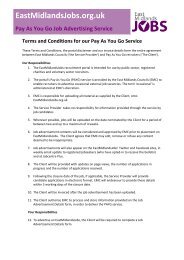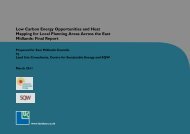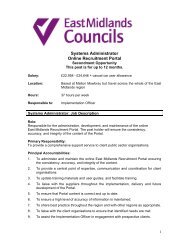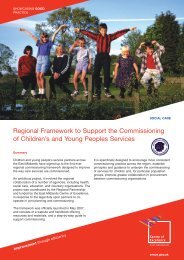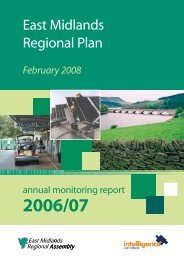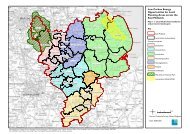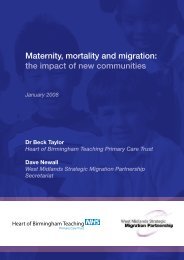East Midlands Regional Spatial Strategy 2005/06
East Midlands Regional Spatial Strategy 2005/06
East Midlands Regional Spatial Strategy 2005/06
You also want an ePaper? Increase the reach of your titles
YUMPU automatically turns print PDFs into web optimized ePapers that Google loves.
<strong>East</strong> <strong>Midlands</strong> <strong>Regional</strong> <strong>Spatial</strong> <strong>Strategy</strong> Annual Monitoring Report <strong>2005</strong>/<strong>06</strong><br />
Tourism remains an important source of employment for the <strong>East</strong> <strong>Midlands</strong>, particularly in Nottinghamshire,<br />
Lincolnshire and Derbyshire (in terms of the numbers employed) and in Rutland (in terms of the proportion of<br />
total jobs), but with significant numbers of jobs throughout the Region.<br />
As of the fourth quarter of <strong>2005</strong> nearly all of <strong>East</strong> <strong>Midlands</strong> households (99.9%) including those in rural and<br />
sparsely populated areas had access to broadband (up from 94% in quarter three of 2004). The actual take-up of<br />
the broadband services is more difficult to measure but qualitative evidence suggests that, as in the rest of the<br />
UK, this is increasing.<br />
Environment<br />
As of September 20<strong>06</strong>, 68% of the Sites of Special Scientific Interest (SSSI) in the <strong>East</strong> <strong>Midlands</strong> were classed as<br />
favourable or unfavourable recovering. In England, as of September 20<strong>06</strong>, 73% of the SSSI areas were classed as<br />
favourable or unfavourable recovering - the <strong>East</strong> <strong>Midlands</strong> still lags behind the nation as a whole.<br />
The 2004/05 monitoring report showed a decrease of 95 in the population of farmlard species in the <strong>East</strong><br />
<strong>Midlands</strong> between 1994 and 2003. The latest data comparing the period 1994 to 2004 shows a reversal of this<br />
decrease so that the population of farmland birds is nearly the same as that in 1994.<br />
Over the last decade the rate of woodland creation supported through grant has been between 500 and 850<br />
hectares per annum.The figure for this year is significant but falls well short of the rate required to meet the<br />
target set out in the current RSS of 65,000 ha by 2021.<br />
Information on Landscape Character Assessments has been provided by Natural England who undertook a<br />
survey in February/March 20<strong>06</strong> showing that 17 local authorities had a Landscape Character Assessment (LCA) in<br />
place and that other local authorities were at different stages of development, with a number of studies<br />
underway.<br />
English Heritage’s Register of Buildings at Risk in 20<strong>06</strong> recorded 133 entries of Grade I and II* listed buildings at<br />
risk in the <strong>East</strong> <strong>Midlands</strong> compared to 134 in <strong>2005</strong>. Seven had been removed and six added to the register from<br />
last year.<br />
The data on planning permissions granted contrary to Environment Agency advice on water quality grounds<br />
shows a substantial decline compared to previously available data and well on the way to meeting the target of<br />
zero permissions granted.<br />
The total number of planning permissions granted contrary to Environment Agency advice on flood risk<br />
grounds was 20 in 2004/05. In 2003/04 it was 133.This represents a significant fall.<br />
Water Quality in the <strong>East</strong> <strong>Midlands</strong> has shown a significant improvement in terms of both chemical and<br />
biological standards since 1990.<br />
The capacity of Combined Heat and Power (CHP) facilities in the <strong>East</strong> <strong>Midlands</strong> in <strong>2005</strong> was 234MWe compared<br />
to 233MWe in 2004. This represents a decline in capacity from 244MWe in 2003. The region is only 50% towards<br />
the 2010 target of 511MWe.<br />
The Region is making steady progress in generating electricity from renewable resources. In 2002 approximately<br />
400 GWh were generated from renewable resources compared to over 600 GWh in <strong>2005</strong>. The main sources of<br />
this renewable energy are other bio-fuels and landfill.<br />
Minerals, Aggregates & Waste<br />
The national and regional guidelines for aggregate provision indicate that the average annual production in the<br />
<strong>East</strong> <strong>Midlands</strong> for sand and gravel should be 11.0 million tonnes (MT) a year and for land won crushed rock, 34.9<br />
10




